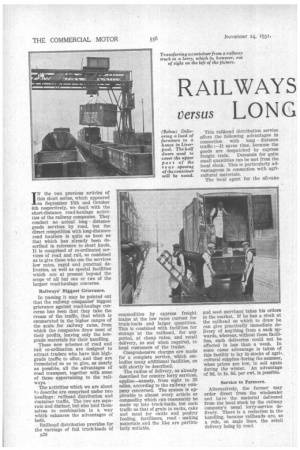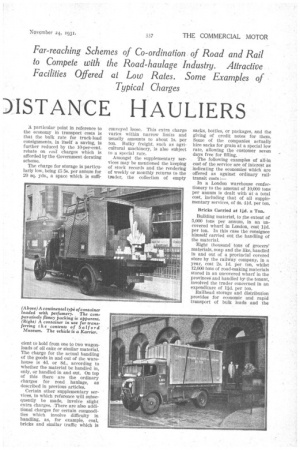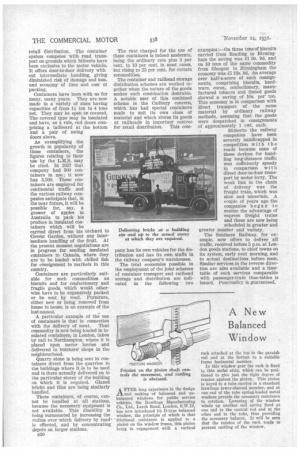RAILWAYS
Page 46

Page 47

Page 48

If you've noticed an error in this article please click here to report it so we can fix it.
Versus LONG DISTANCE HAULIERS IN the two previous articles of this short series, which appeared on September 15th and October 6th respectively, we dealt with the short-distance road-haulage activities of the railway companies. They conduct no actual long distance goods services by road, but the direct competition with long-distance road hauliers is quite as keen as that which has already been described in reference to short hauls. It is comprised of co-ordinated services of road and rail, so combined as to give those who use the services low rates, rapid and punctual deliveries, as well as special facilities which are at present beyond the scope of all but one or two of the largest road-haulage concerns.
Railways' Biggest Grievance.
In .passing it may be pointed out that the railway companies' biggest grievance against road-haulage concerns has been that they take the cream of the traffic, that which is enumerated in the higher ranges of the scale for railway rates, from which the companies draw most of their profits, leaving only the lowgrade materials for their handling.
These new schemes of road and rail co-ordination are designed to attract traders who have this highgrade traffic to offer, and they are formulated so as to give, as nearly as possible, all the advantages of road transport, together with some of those appertaining to the railways.
The activities which we are about to describe are comprised under two headings: railhead distribution and Container traffic. The two are separate and distinct, but also lend themselves to combination in a way which enhances the advantages of both.
Railhead distribution provides for the earriage of full truck-loads Of n28 commodities by express freight trains at the low rates current for truck-loads and larger quantities. This is combined with facilities for storage at the railhead, for any period, at cheap rates, and retail delivery, as and when required, to local customers of the trader.
Comprehensive charges are made for a complete service, which embodies many additional facilities, as will shortly be described.
The radius of delivery, as already described for country lorry services, applies—namely, from eight to 20 miles, according to the railway company concerned. The system is applicable to almost every article or commodity which can reasonably be made up into truck-loads, but such traffic as that of grain in sacks, cake and meal for cattle and poultry feeding, fertilizers, road making materials and the like are particularly suitable.
and seed merchant takes his orders in the market. If he has a stock at the railhead on which to draw he can give practically immediate delivery of anything from a sack upwards, whereas, without these facilities, such deliveries could not be effected in less than a week. In some cases advantage is taken of this facility to lay in stocks of agricultural supplies during the summer, when prices are low, to sell again during the winter. An advantage of 8d. to 1s. 8d. per cwt. Is possible.
Service to Farmers.
Alternatively, the farmer may order direct from the wholesaler and have the material delivered from the local stock by the railway company's usual lorry-service delivery. There is a reduction in the handling, because railheads are, as a rule, on main lines, the retail delivery being by road.
'A particular point in reference to the economy in transport costs is that the bulk rate for truck-load consignments, in itself a saving, is further reduced by the 10-per-cent. rebate on rail charges which is afforded by the Government derating scheme.
The charge for storage is particularly low, being £5 5s. per annum for 20 sq. yds., a space which is suffi (Above) A continental type of container loaded with perfumery. The cont.. paratively flimsy packing is apparent. (Right) A container in use for transferring the contents of Salford Museum. The vehicle is a Karrier,
dent to hold from one to two wagonloads of oil cake or similar material. The charge for the actual handling of the goods in and out of the warehouse is 4d. or 8d., according to whether the material be handled in, only, or handled in and out. On top of this there are the ordinary charges for road haulage, as described in previous articles.
Certain other supplementary services, to which reference will subsequently be made, involve slight extra charges. There are also additional charges for certain commodities which involve difficulty in handling, as, for example, coal, bricks and similar traffic which is conveyed loose. This extra charge varies within narrow limits and usually amounts to about is. per ton. Bulky freight, such as agricultural machinery, is also subject to a special rate.
Amongst the Supplementary services may be mentioned the keeping of stock records and the rendering of weekly or monthly returns tothe trader, the collection of empty sacks, bottles, or packages, and the giving of credit notes for them. Some of the companies actually hire sacks for grain at a special low rate, allowing the customer seven days free for filling.
The following examples of all-in cost of the service are of interest as indicating the economies which are offered as against ordinary railtransit costs:— In a London warehouse confectionery to the amount of 10,000 tons per annum is dealt with at a total cost, including that of all supplementary services, of 4s. 4id. per ton.
Bricks Carried at lid. a Ton.
Building materiel, to She extent of 5,000 tons per annum, in an uncovered wharf in London, cost lid. per ton. In this case the consignee himself carried out the handling of the material.
Eight thousand tons of grocers' materials, soap and the like, handled in and out of a provincial covered store by the railway company, in a year, cost 2s. Id. Per ton, whilst 12,000 tons of road-malting materials stored in an uncovered wharf in the provinces and handled by. the tenant, involved the trader concerned in an expenditure of lid, per ton.
Railhead storage and distribution provides for economic and rapid transport of bulk loads and the retail distribution. The container system competes with road transport on grounds which hitherto have been exclusive to the motor vehicle. It offers door-to-door delivery with out intermediate handling, giving diminished risk of damage and loss. and economy of time and cost of packing.
Containers have been with us for many, many years. They are now made in a variety of sizes having capacities of from 11 ton to 4 tons net. They may be open or covered. The covered type may be insulated and have, as a rule, end doors comprising a tailboard at the bottom and a pair of swing doors above.
As exemplifying the growth in popularity of these containers, the figures relating to their use by the L.M.S. may be cited. In 1927 that company had 300 containers in use ; it now has 3,500. These con tainers are employed for continental traffic and the various railway com panies anticipate that, in the near future, it will be possible for, say, a grower of apples in Australia to pack his produce in insulated containers which will be carried direct from his orchard to Covent Garden, without any intermediate handling of the fruit. At the present moment negotiations are in progress for sending insulated containers to Canada, where they are to be loaded with chilled fish for consignment to markets in this country.
Containers are particularly suitable for such commodities as biscuits and for confectionery and fragile goods, which would otherwise have to be expensively packed or be sent by road. Furniture, either new or being removed from house to house, is an example of the last-named.
A particular example of the use of containers is that in connection with the delivery of meat. That commodity is now being loaded in insulated containers, in London, taken by rail to Northampton, where it is placed upon motor lorries and delivered to butchers' shops in the neighbourhood.
Quarry stone is being sent in containers direct from the quarries to the buildings where it is to be used and is there actually delivered on to the particular storey of the building on which it is required. Glazed bricks and tiles are being similarly handled.
These containers, of course, cannot be handled at all stations, because the necessary equipment is not available. This disability is being surmounted by increasing the radius over which delivery by roadis effected, and by concentrating depots on larger stations.
B30 The rate charged for the use of these containers is indeed moderate, being the ordinary rate plus 5 per Cent. to 10 per cent, in most cases, but rising to 25 per cent. for certain commodities.
The container and railhead storage distribution schemes are worked together when the nature of the goods makes such combination desirable. A notable user of this combined scheme is the Cadbury concern, which has had special containers made to suit its own class of material and which stores its goods at railheads in important centres for retail distribution. This corn
pany has its own vehicle's for the distribution and has its own staffs in the railway company's warehouses.
The total economies possible in the employment of the joint schemes of container transport and railhead storage and distribution are indicated in the following two
AFTER long experience in the design and making of balanced and unbalanced windows for public service vehicles, the Rawlings Manufacturing Co., Ltd., Larch Road, London, S.W.12, has now introduced its D-type balanced window, the principle of which is that frictional .resistance is applied to a pinion on the window frame, this pinion being in engagement with a vertical
examples :—On three tons of biscuits carried from Reading to Birmingham the saving was £1 9s. 9d. and on 10 tons of the same commodity from Glasgow to Birmingham the economy was £5 16s. 8d. An average over half-a-score of such consignments, comprising biscuits, hardware, cocoa, confectionery, manufactured tobacco and tinned goods showed a saving of 10s. per ton. This economy is in comparison with direct transport of the same material by ordinary railway methods, assuming that the goods were despatched in consignments of approximately 1 cwt. each.
Hitherto the railway companies have been severely handicapped in competition with the roads because none of these devices for handling long-distance traffic was .sufficiently speedy in comparison wit it direct door-to-door transport by motor lorry. The • weak link in the chain of delivery was the freight train, which was slow and uncertain. A couple of years ago the companies began to realize the advantage of express freight trains and these are now being scheduled in greater and greater number and variety.
The Southern Railway, for example, now offers to deliver all traffic, received before 5 p.m. at London goods stations, to chief towns on its system, early next morning, and to actual destinations before noon. Similar services in the reverse direction are also available and a timetable of such services comparable with passenger-train time-tables is issued. Punctuality is guaranteed.
rack attached at the top to the garnish rail and at the bottom to a suitable frame horizontal member.
In this window gear the rack is fixed to thin metal strip, which can be positioned to give just the right degree of tension against the pinion. This pillion is keyed to a tube carried in a standard Rawlings lower-channel member, and at one end of the tube spring-loaded metal washers provide the necessary resistance to rotation. Lowering of the window winds up another coil spring fixed at one end to the central rod and at the other end to the tube, thus providing the necessary balance. It will be seen that the tension of the rack tends to prevent rattling of the window.




































































































